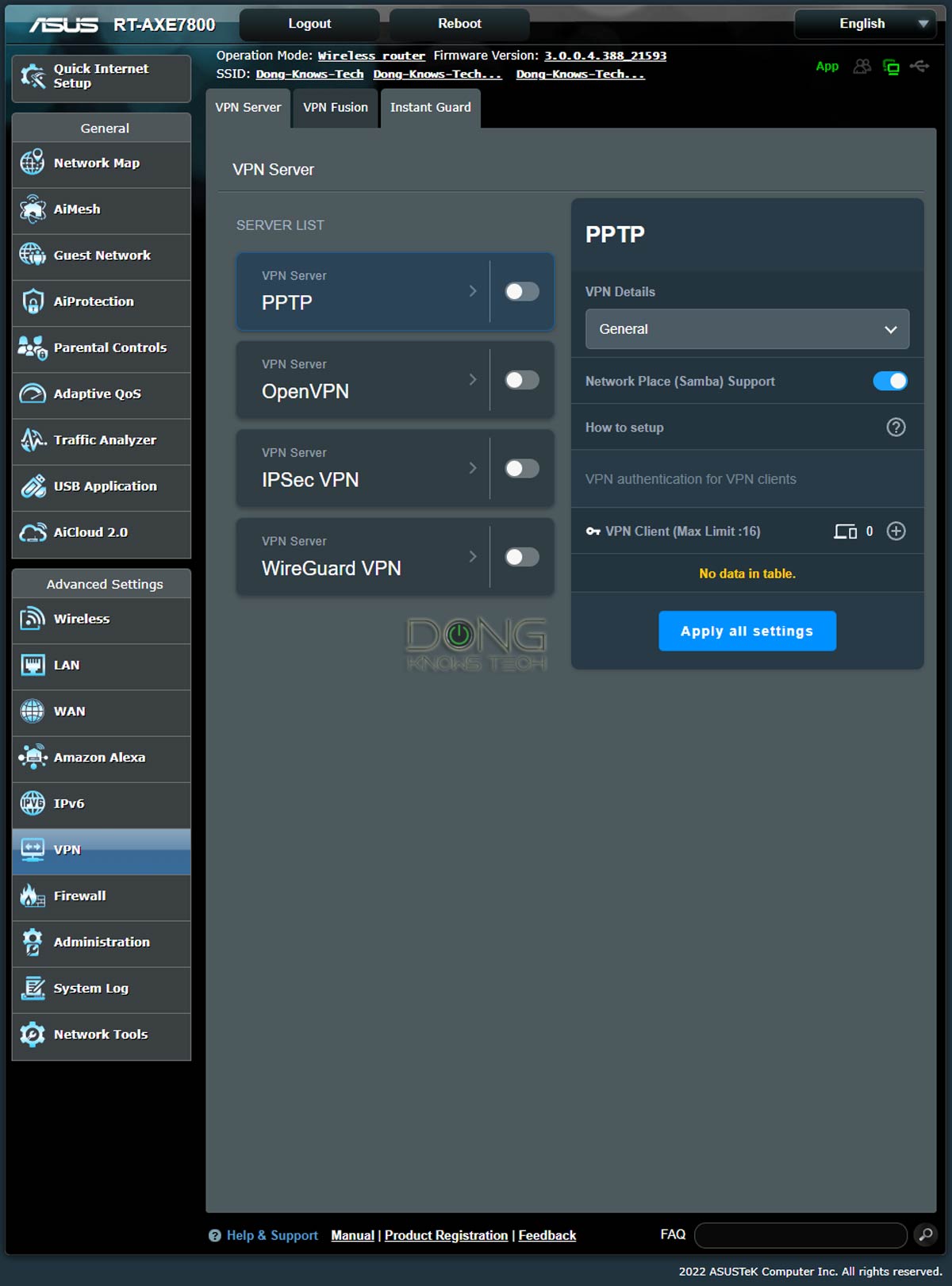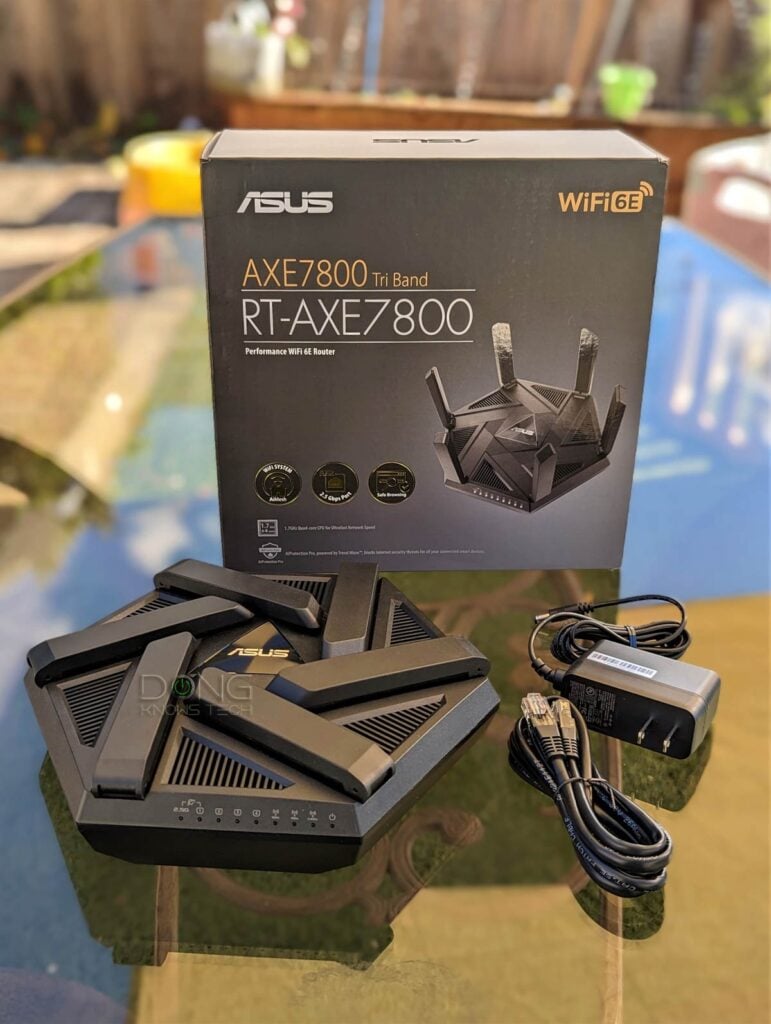The RT-AXE7800 is not Asus’s first Wi-Fi 6E Tri-Band router — far from it.
But the new router still manages to be unique. Its hardware specs remind me of the Netgear RAXE300, and its appearance brings back the good memories of the RT-AX89X.
As a Wi-Fi 6E machine, you can call the RT-AXE7800 a mini and somewhat stripped-down version of the GT-AXE11000. But thanks to its significantly lower cost of around $330, the new router makes an excellent buy.
If you’re into Wi-Fi 6E and live in a relatively small home, pick the RT-AXE7800 today!
Dong’s note: I first published this piece on December 2, 2022, as a preview and updated it into an in-depth review after thorough hands-on testing on December 13.

Asus RT-AXE7800: An excellent Wi-Fi 6 standalone router
Out of the box, the RT-AXE7800 is smaller than I expected, just about two-thirds the size and weight of the GT-AXE11000. And that’s a good thing since the latter is quite bulky.
Despite the smaller size, the new router manages to have a 2.5Gbps port which can work as the WAN (default) or a LAN port. It also has impressive processing power, albeit slightly below the previous model.
With that, let’s check the tech. For comparison, I’ll throw the RT-AX89X in the mix. It’s an entirely different router with the same iconic non-detachable collapsible antenna design.
Hardware specifications: Asus RT-AXE7800 vs GT-AXE11000 vs RT-AX89X
The biggest diffidence between the distinctive-looking RT-AXE7800 and GT-AXE11000 is in their Wi-Fi specs.
The two share the same 5GHz band, but the latter’s 2.4GHz and 6GHz are more powerful, each with twice the bandwidth of the former.


Other than that, the GT-AXE11000 is also a gaming router by trade — it’s part of Asus’s ROG family.
While you can play games with the RT-AXE7800 and customize the setting using QoS, it doesn’t have any special gaming features, such as a dedicated game port or mobile game mode, and so on.
In most cases, though, it’s safe to say the RT-AXE7800 will deliver a similar Wi-Fi experience as the GT-AXE11000. In fact, if you don’t care about the 6Hz, or 10Gbps wired connections, you’ll get a similar experience from the RT-AXtoo.


Asus RT-AXE7800: A familiar Asus experience
Like the rest of Asus Wi-Fi 6 and Wi-Fi 6E routers, the RT-AXE7800 uses the Asuswrt firmware to deliver a robust web user interface, a standard setup process, and a host of helpful network settings and features.


You can read more about them in this post on Asus Wi-Fi broadcasters, but below are a few highlights.
- Universal setting restoration: You can restore the backup files of most previous Wi-Fi 6 and 6E routers on the RT-AXE7800. It’s an excellent way to upgrade without having to reprogram your network from scratch.
- Free Dynamic DNS: The RT-AXE7800 supports all existing Dynamic DNS (DDNS) services and also comes with a free domain provided by Asus. No matter which you use, a free SSL certificate.
- Helpful mobile app — no login account required for remote access: Other than the robust web user interface, you can use the Asus Router mobile app. Whether you use this app or the web UI, you can manage the router remotely without a login account with Asus — which means fewer privacy risks.
- Built-in online protection Parental Controls: Like all Asus routers, the RT-AXE7800 includes AiProtection and Parent Controls that are free for life, adding a lot of value to the hardware.
- Adaptive QoS: QoS is a common feature in home routers, and the RT-AXE7800 comes with Adaptive QoS, which is both easy to use and effective. You can use it to quickly prioritize the network for gaming, working, media streaming, or any other needs.
- AiMesh: AiMesh is a valuable feature available in all Asus Wi-Fi 6/6E and most Wi-Fi 5 routers that turn multiple standalone routers into a robust mesh Wi-Fi system. The RT-AXE7800 can work as the primary router or a satellite node of an AiMesh system. For best performance, though, you only use it in one with wired backhauling.
- Flexible port configuration: Like all Asus routers, you can do a lot with the RT-AXE7800’s network ports. Specifically:
- The router has a 2.5Gbps WAN port (default) and a 1Gbps WAN (working as the LAN1 by default.) Either can function as the WAN port, and the other will work as a LAN.
- You can combine the 1Gbps WAN port and the LAN2 port into a WAN Link Aggregation setup to host a 2Gbps broadband connection.
- When the 2.5Gbps (or the USB port) works as the WAN port, the LAN1 and LAN2 ports can work together to create a 2Gbps LAN Link Aggregation connection.
- The router support Dual-WAN where you can use one of its WAN ports (2.5Gbps WAN or the LAN1 port) to host a broadband connection and another LAN port (or the USB port) to host another simultaneously.
- Many VPN options: The RT-AXE7800 can work as a VPN server of all VPN flavors, including the support for VPN Fusion, which allows assigning a specific connected client to a particular VPN connection. It also has Instant Guard, a special VPN server for mobile devices.
- Other useful features: Other than the above, you can also expect the following from all Asus routers:
- Networking tools: Wake on LAN, Ping, Netstat, and Smart Connect Rule can come in handy for advanced users.
- Auto-reboot: You can set your router to restart by itself on a schedule.
- Traffic Analyzer: A set of tools and statistics for those wanting to find out what’s happening in the network.
- USB-related features galore: When hosting a storage device, the router has all the features you can imagine — from data sharing (locally and over the Internet) to backup (including the support for Time Machine) to a personal cloud. You can make the router handle PC-less downloading and use the router’s USB ports to host printers or select USB cellular modems.
- The standard set of network settings and features: These include IP reservation, Port-forwarding, so on and so far, and even some Alexa Skills.
- Frequent firmware update: Asus pushes out firmware updates regularly to fix issues and improve its routers’ performance and function. You can choose to update manually or turn on auto-update.
AiMesh: Asus’s ongoing journey to bettering Wi-Fi coverage


In all, the Asus RT-AXE7800 is one of the most feature-rich Wi-Fi 6E routers you can find. And going forward, it might get the Merlin treatment, too, like in the case of the GT-AXE11000 and GT-AXE16000.
Asus RT-AXE7800: Detail photos





Note how it’s wall-mount-ready.


Asus RT-AXE7800: Excellent performance
For this review, I used the RT-AXE7800 extensively as a standalone router, and it proved to be an excellent performer overall.
Fast Wi-Fi throughputs, extensive coverage
As a Wi-Fi machine, the RT-AXE7800 delivered excellent through speeds, especially on the 5GHz band, which has non-compromising specs. The router’s 2.5Gbps LAN port definitely helped with how I test Wi-Fi routers.
It also passed my 3-day stress test with flying colors without any disconnection, and the coverage is comparable to that of the GT-AXE11000.


It’s hard to quantify the Wi-Fi range, but if you live in a home of around 2000 ft2 (186 m2) and place it at the center, you’ll be able to get Wi-Fi signals everywhere.
However, remember that its 6GHz band is much shorter in range compared to the other two bands. Generally, within a line of sight, you can get the 6GHz signals from up to 75 feet away, but behind or wall or two, expect no more than half of that.
A great wired AiMesh member
I tested the RT-AXE7800 router briefly with AiMesh, and it worked as intended.
Generally, it’s best to use it with other Wi-Fi 6E routers — such as the GT-AXE1100 or ZenWiFi ET8. As a rule for any router without an additional band for dedicated backhauling, you should use it in a wired home.

I tried it out as the satellite for the GT-AXE11000, and with the latest firmware, the setup process was smooth, and I could even get a Multi-Gig backhaul out of the two. And in this case, the RT-AXE7800’s Wi-Fi performance was the same as when it was working as a standalone router.
Could-be-better NAS performance when hosting a storage device
The 2.5Gbps did’ help much with the RT-AXE7800’s network-attached storage performance when it hosts a portable drive via its USB port.
I tested it with a WD My Password portable SSD, averaging around 60MB/s for writing and slightly over 100MB/s for reading. While these numbers weren’t too happy, they were lower than many others with a Mulit-Gig LAN port.


Still, at these sustained speeds, you can turn the RT-AXE7800 into a viable mini NAS server with a good portable SSD. Or you can go ahead and get a real NAS server instead.
Pros
Excellent performance with tons of network settings with an excellent feature set, free online protection, and Parental Controls
AiMesh 2.0 support with Mult-Gig wired backhauling as a satellite
Super-flexible network ports for Dual-WAN and LAN/WAN Link Aggregations
Compact and practical design; relatively affordable
Conclusion
The Asus RT-AXE7800 is an excellent yet familiar Wi-Fi 6E router. Compared to the previous GT-AXE1100, it arrives at a much better time now that Wi-Fi 6E clients are aplenty. That, plus the newer firmware and the $100 cheaper price tag, only helps.
If you’re in the market for a standalone broadcaster, or if you have a wired home, at the current street price of around $330, the RT-AXE7800 is an excellent buy. Get one or two today!






More Stories
C++ overtakes Java in language popularity index
Electrohome Montrose turntable & McKinley speakers review
GitHub Copilot for Business plans unveiled